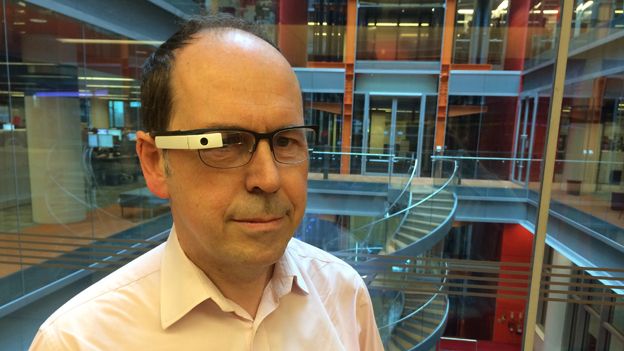Google Glass - a fascinating failure?
- Published
- comments

I've been wearing it for six weeks now, indoors and out, at work and at home, in restaurants, on the tube - even at the dentist.
I've been getting quizzical looks in the street, coupled with jibes and mockery from family and colleagues. So now is the time for me to try to reach a few conclusions about Google Glass.
Google Glass is a prototype product which puts the kind of information and applications you get on a smartphone into a tiny screen above the user's right eye.
And sadly my verdict is that, in its present form with its current software, Google Glass is a failure. A fascinating, promising, sometimes brilliant product - but a failure nonetheless. While software developers and the wealthiest of early adopters are now rushing to buy it in the US, I think it lacks the sheer usefulness that would make it a must-have device for the mass market.
But let's have a look through Glass's ups and downs:
How it looks
A few weeks ago Google brought out some frames for Glass that made it appear a little more stylish, but "geeky" is still the word that springs most often to people's lips when I ask them to describe how I look wearing the device. To some, that is now a compliment but Google will not reach a wider section of the public with something that makes them feel self-conscious.
Members of the public give their reaction to Rory Cellan-Jones wearing Google Glass
As you will see from the video above, it does spark interest and some positive reactions, and wearing it in public means stopping every five minutes to give someone a go. Quite a few, my dentist among them, think it is tremendously cool, but I'm not convinced many would want to wear it every day.
User interface
You do get used to swiping your finger along the side of the device to move through various menu items but it still feels clunky, and every time there is a software update, the device seems to crash a lot. You are all too aware that this is still a beta product.
The voice control is very good for simple commands ("Ok Glass, take a picture") but pretty useless for anything longer or more testing such as a search or adding a caption to a tweet. Part of the problem is that Google doesn't seem to understand my British English. A caption to a photo that was meant to read "garden looking unusually tidy" ended up reading "Gordon looking I'm usually Thai tea."
Camera
The tiny camera built into the frame is by far the most useful aspect of the device. I've used it to grab photos and in particular video in all sorts of situations - watching a football match from the terraces, kneading and baking bread, getting onto an overstuffed train during a London tube strike. The quality is reasonable - equivalent to the camera on a cheaper smartphone - and you do get photos and angles that wouldn't happen without a device perched on your nose.
Privacy
I think the privacy concerns are somewhat overblown - the very fact that it does look so geeky makes Glass far less covert a device than many others on the market. After all, you can now get a wearable camera that looks like a brooch and takes random photos everywhere you go. But a red light flashing when Glass is recording would be a sensible addition.
Other functions
Right now, Glass just doesn't have enough functions. I have found it mildly useful to hear a ping and look up and see a tweet or an email without getting my phone out. The simple digital clock on the main menu is also helpful when you're rushing to get somewhere.
But getting directions, especially given Glass's inability to understand me, is nearly always not worth the bother, and as for reading recipes from the All Of The Cooks app or using the instant translation tool Word Lens, both have proved too fiddly for this impatient user.
The concern is that this product has been in the hands of developers for a year now but on the Glassware store, there are still only around 60 apps. I have seen various demos of what look like exciting augmented reality apps - services that overlay information on what you see through Glass - but so far these have not appeared in the store.
I have also come across organisations, from museums to hospitals to oil companies, which are exploring exciting ways to use Glass to improve the work they do.
But what is lacking in this project right now is momentum. When the device was unveiled at Google I/O in 2012 with an extraordinary live skydiving demo, there was justifiable excitement. But two years on Glass does not appear to have made much progress. Indeed some functions - notably the ability to make live video calls - have even been removed during software updates.
I am still excited by the promise of wearable computers, and convinced that this is a trend that will go mainstream at some point in the next five years. But that will depend on powerful pervasive networks and devices that are both attractive to wear and so easy to use that you forget that you have them on. Google Glass is still in development, so maybe it will regain some of that lost momentum. But right now, the early leader in the wearable tech race is looking a little out of breath.